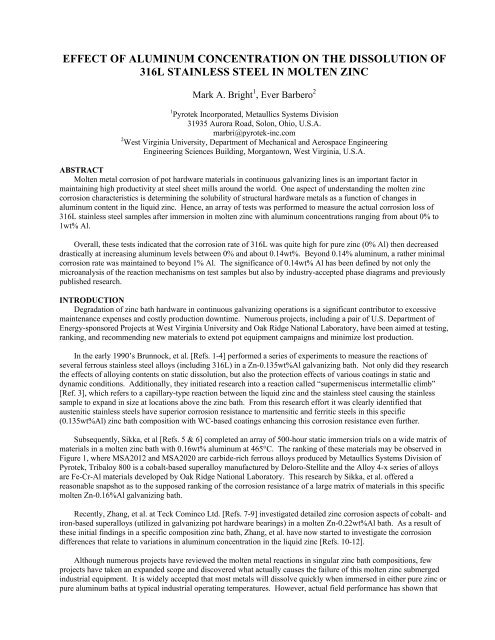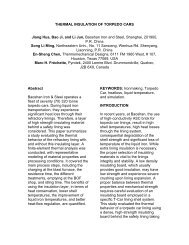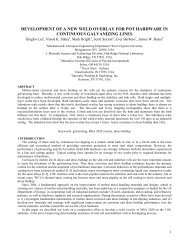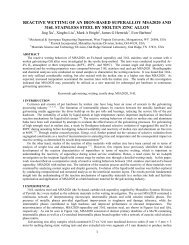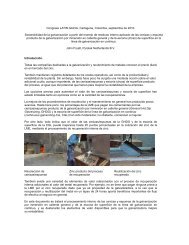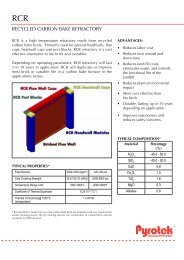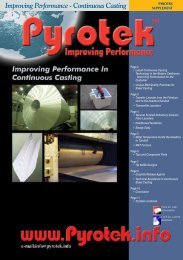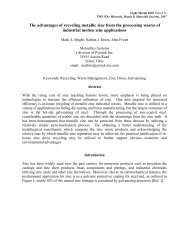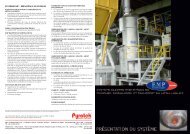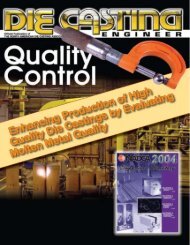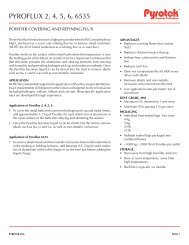EFFECT OF ALUMINUM CONCENTRATION ON THE ... - Pyrotek
EFFECT OF ALUMINUM CONCENTRATION ON THE ... - Pyrotek
EFFECT OF ALUMINUM CONCENTRATION ON THE ... - Pyrotek
Create successful ePaper yourself
Turn your PDF publications into a flip-book with our unique Google optimized e-Paper software.
<strong>EFFECT</strong> <strong>OF</strong> <strong>ALUMINUM</strong> <strong>C<strong>ON</strong>CENTRATI<strong>ON</strong></strong> <strong>ON</strong> <strong>THE</strong> DISSOLUTI<strong>ON</strong> <strong>OF</strong><br />
316L STAINLESS STEEL IN MOLTEN ZINC<br />
Mark A. Bright 1 , Ever Barbero 2<br />
1 <strong>Pyrotek</strong> Incorporated, Metaullics Systems Division<br />
31935 Aurora Road, Solon, Ohio, U.S.A.<br />
marbri@pyrotek-inc.com<br />
2 West Virginia University, Department of Mechanical and Aerospace Engineering<br />
Engineering Sciences Building, Morgantown, West Virginia, U.S.A.<br />
ABSTRACT<br />
Molten metal corrosion of pot hardware materials in continuous galvanizing lines is an important factor in<br />
maintaining high productivity at steel sheet mills around the world. One aspect of understanding the molten zinc<br />
corrosion characteristics is determining the solubility of structural hardware metals as a function of changes in<br />
aluminum content in the liquid zinc. Hence, an array of tests was performed to measure the actual corrosion loss of<br />
316L stainless steel samples after immersion in molten zinc with aluminum concentrations ranging from about 0% to<br />
1wt% Al.<br />
Overall, these tests indicated that the corrosion rate of 316L was quite high for pure zinc (0% Al) then decreased<br />
drastically at increasing aluminum levels between 0% and about 0.14wt%. Beyond 0.14% aluminum, a rather minimal<br />
corrosion rate was maintained to beyond 1% Al. The significance of 0.14wt% Al has been defined by not only the<br />
microanalysis of the reaction mechanisms on test samples but also by industry-accepted phase diagrams and previously<br />
published research.<br />
INTRODUCTI<strong>ON</strong><br />
Degradation of zinc bath hardware in continuous galvanizing operations is a significant contributor to excessive<br />
maintenance expenses and costly production downtime. Numerous projects, including a pair of U.S. Department of<br />
Energy-sponsored Projects at West Virginia University and Oak Ridge National Laboratory, have been aimed at testing,<br />
ranking, and recommending new materials to extend pot equipment campaigns and minimize lost production.<br />
In the early 1990’s Brunnock, et al. [Refs. 1-4] performed a series of experiments to measure the reactions of<br />
several ferrous stainless steel alloys (including 316L) in a Zn-0.135wt%Al galvanizing bath. Not only did they research<br />
the effects of alloying contents on static dissolution, but also the protection effects of various coatings in static and<br />
dynamic conditions. Additionally, they initiated research into a reaction called “supermeniscus intermetallic climb”<br />
[Ref. 3], which refers to a capillary-type reaction between the liquid zinc and the stainless steel causing the stainless<br />
sample to expand in size at locations above the zinc bath. From this research effort it was clearly identified that<br />
austenitic stainless steels have superior corrosion resistance to martensitic and ferritic steels in this specific<br />
(0.135wt%Al) zinc bath composition with WC-based coatings enhancing this corrosion resistance even further.<br />
Subsequently, Sikka, et al [Refs. 5 & 6] completed an array of 500-hour static immersion trials on a wide matrix of<br />
materials in a molten zinc bath with 0.16wt% aluminum at 465°C. The ranking of these materials may be observed in<br />
Figure 1, where MSA2012 and MSA2020 are carbide-rich ferrous alloys produced by Metaullics Systems Division of<br />
<strong>Pyrotek</strong>, Tribaloy 800 is a cobalt-based superalloy manufactured by Deloro-Stellite and the Alloy 4-x series of alloys<br />
are Fe-Cr-Al materials developed by Oak Ridge National Laboratory. This research by Sikka, et al. offered a<br />
reasonable snapshot as to the supposed ranking of the corrosion resistance of a large matrix of materials in this specific<br />
molten Zn-0.16%Al galvanizing bath.<br />
Recently, Zhang, et al. at Teck Cominco Ltd. [Refs. 7-9] investigated detailed zinc corrosion aspects of cobalt- and<br />
iron-based superalloys (utilized in galvanizing pot hardware bearings) in a molten Zn-0.22wt%Al bath. As a result of<br />
these initial findings in a specific composition zinc bath, Zhang, et al. have now started to investigate the corrosion<br />
differences that relate to variations in aluminum concentration in the liquid zinc [Refs. 10-12].<br />
Although numerous projects have reviewed the molten metal reactions in singular zinc bath compositions, few<br />
projects have taken an expanded scope and discovered what actually causes the failure of this molten zinc submerged<br />
industrial equipment. It is widely accepted that most metals will dissolve quickly when immersed in either pure zinc or<br />
pure aluminum baths at typical industrial operating temperatures. However, actual field performance has shown that
standard metal alloys can survive for an appreciable amount of time in a typical molten zinc-aluminum alloy bath used<br />
in industrial galvanizing operations. Thus, a logical thought process would indicate that a minimum dissolution rate in<br />
zinc may be obtained at a given aluminum concentration somewhere between 0% and 100% Al.<br />
Weight Loss in 500hrs. (mg/sq.cm)<br />
250<br />
200<br />
150<br />
100<br />
50<br />
0<br />
0.5 0.5<br />
7 8<br />
20<br />
55<br />
60 60<br />
76<br />
90<br />
110<br />
140<br />
150<br />
Tribaloy 800<br />
W-20Mo Weld Overlay<br />
MSA2012<br />
MSA2020<br />
D2 Steel<br />
A2 Steel<br />
Stellite 6<br />
ORNL Alloy 4-2<br />
ORNL Alloy 4-3<br />
ORNL Alloy 4-4<br />
316L (cast)<br />
ORNL Alloy 4<br />
316L (sheet)<br />
ORNL Alloy 4-1<br />
Figure 1: Sample corrosion results after 500 hour static immersion<br />
in Zn-0.16%Al at 465°C [Ref. 6]<br />
2<br />
220<br />
Table 1: 316L Stainless Steel<br />
used in zinc corrosion testing<br />
element wt%<br />
Fe 67.51<br />
C 0.012<br />
Si 0.40<br />
Mn 1.39<br />
S 0.029<br />
P 0.024<br />
Cr 17.55<br />
Ni 10.74<br />
Mo 2.05<br />
Cu 0.257<br />
N 0.0512<br />
EXPERIMENTAL<br />
As a result, a series of experiments [Ref. 13] were executed to identify the molten zinc dissolution characteristics<br />
and associated substrate reaction mechanisms of 316L stainless steel at increasing aluminum concentrations in the zinc<br />
bath. (316L stainless is the most common structural material employed for galvanizing bath hardware.) Corrosion<br />
samples (50.8mm long x 15.88mm dia.) of 316L stainless steel were machined to precise dimensions (±0.04mm) and<br />
immersed in a bath of clean, new, SHG-grade (99.99% pure) zinc (41kg) containing the required amount of pure<br />
aluminum addition which was heated to 500°C in an electric resistance kiln furnace. (Composition of the 316L samples<br />
is outlined in Table 1.) At given time intervals, a 316L corrosion sample was removed from the zinc bath and a<br />
representative zinc sample was taken.<br />
After all the 316L corrosion samples had been extracted from the bath, test specimens were prepared for analysis.<br />
Most corrosion samples were pickled in a dilute (15%) HCl solution to remove the zinc coating and were then weighed<br />
and measured to determine the weight loss and surface area reduction. However, several samples were preserved with<br />
the solidified zinc as-is then sectioned and polished for microstructural and elemental analysis by scanning electron<br />
microscope (SEM) with energy dispersive spectrometry (EDS). In addition, zinc bath samples were subjected to<br />
Inductively Coupled Plasma (ICP) analysis to determine exact chemical composition.<br />
Following these procedures, the 316L stainless steel reactions in six different zinc baths at 500°C with aluminum<br />
concentrations ranging from nearly zero percent to approximately 1wt% aluminum were observed. As outlined in<br />
Figure 2, the dissolution rate of 316L stainless steel varied tremendously as a function of aluminum concentration in the<br />
zinc bath. As the aluminum percentage was increased, the corrosion rate diminished. Hence, if the average (linear)<br />
dissolution rate of each sample series is calculated, a rate of change with time may be calculated. Plotting this time-rate<br />
reaction, the distinct reduction in dissolution rate of 316L with regards to aluminum concentration in the zinc bath is<br />
discerned from Figure 3. At very low aluminum levels (near 0wt%), the dissolution rate was very high (> 4mg/cm 2 /hr),<br />
but as the aluminum level was increased from ~0wt% to about 0.14wt%, the dissolution rate dropped sharply (to less<br />
than 1mg/cm 2 /hr). Subsequently, beyond 0.14wt% aluminum, the rate change was less aggressive and quickly<br />
stabilized at around 0.2mg/cm 2 /hr. From Figure 3, it is clearly identified that slight changes in the aluminum<br />
concentration of a galvanizing bath may have a significant impact on the solubility, wear and degradation of the 316L<br />
stainless steel pot hardware submerged therein.
Sample Corrosion (mg/cm 2 )<br />
0<br />
-100<br />
-200<br />
-300<br />
-400<br />
-500<br />
-600<br />
-700<br />
-800<br />
-900<br />
0 1 2 3 4 5<br />
Days<br />
6 7 8 9 10 11 12<br />
3<br />
0.002%Al, 0.090%Fe<br />
0.046%Al, 0.000%Fe<br />
0.117%Al, 0.004%Fe<br />
0.243%Al, 0.003%Fe<br />
0.492%Al, 0.003%Fe<br />
1.09%Al, 0.039%Fe<br />
Figure 2: Molten Zinc-Aluminum corrosion (at 500°C) of 316L stainless steel with respect to<br />
instantaneous surface area of each sample<br />
Dissolution Rate (mg/cm 2 /hr)<br />
0<br />
-0.5<br />
-1<br />
-1.5<br />
-2<br />
-2.5<br />
-3<br />
-3.5<br />
-4<br />
-4.5<br />
-5<br />
Bath Aluminum Concentration (wt%)<br />
0 0.2 0.4 0.6 0.8 1<br />
Figure 3: Zinc corrosion rate of 316L stainless steel as a function of<br />
aluminum concentration (at 500°C)<br />
As noted, a significant modification in the zinc dissolution rate of 316L occurs in the region of 0.14wt% aluminum.<br />
Reviewing the Zn-rich corner of the Zn-Fe-Al phase diagram [Refs. 14 & 15] at 500°C (Figure 4), a phase transition<br />
(from δ to η) is identified at 0.14wt% aluminum, which is commonly known as the “knee-point”. It is widely<br />
understood that the “knee point” governs the differentiation between galvanneal (0.14wt% Al) coated steel [GI]. Thus, comparing Figure 3 and Figure 4, it can be concluded that the<br />
phase transition from GA to GI not only has a defined effect on the steel substrate being galvanized, but also has a<br />
profound impact on the degradation of the submerged galvanizing hardware.
Iron (wt%)<br />
0.12<br />
0.1<br />
0.08<br />
0.06<br />
0.04<br />
0.02<br />
0<br />
L + ξ<br />
L+ ξ + δ<br />
L<br />
0 0.02 0.04 0.06 0.08 0.1 0.12 0.14 0.16 0.18 0.2 0.22 0.24<br />
Aluminum (wt%)<br />
Figure 4: Zinc-rich corner of the Zn-Fe-Al phase diagram (at 500°C)<br />
[Refs. 14 & 15]<br />
Moreover, in order to obtain a deeper understanding of the reaction products on the 316L stainless steel samples<br />
explored in this investigation, advanced analysis techniques were employed utilizing a Hitachi S-4700 Scanning<br />
Electron Microscope (SEM) with integral EDAX Genesis Energy Dispersive Spectrometer (EDS). From this analysis,<br />
structural changes in the surface reactions relative to variations in the bath aluminum concentration were traced. The<br />
zinc bath containing 0.117wt% Al created no aluminum diffusion into the 316L surface (Figure 5) and the sample<br />
exhibited about 8wt% Fe accumulation immediately above the substrate and approximately 5wt% Fe at the outer<br />
coating surface.<br />
Then, as the aluminum content of the trial zinc bath was increased above the “knee-point” (~0.14wt% Al)<br />
described earlier, the 316L stainless samples immediately began to reflect formations of a Fe2Al5Znx interface layer.<br />
The reaction on 316L following immersion in liquid zinc with 0.243wt% Al at 500°C showed distinct particles of<br />
Fe2Al5Znx forming at the surface of the 316L substrate in less than 24 hours (Figure 6). Concurrently, aluminum is<br />
reacting into the surface of the 316L creating a Fe2Al5Znx composition containing high concentrations of molybdenum<br />
(4wt% Mo) and chromium (~1wt% Cr). Furthermore, the reduced dissolution due to the creation of the interface<br />
(inhibition) layer by the enhanced bath aluminum content has propagated a residual coating that is significantly lower in<br />
iron and other alloying components (such as Cr, Ni and Mo) than the samples from the lower (
83.5wt% Zn<br />
7.6wt% Fe<br />
1.0wt% Cr<br />
2.6wt% Mo<br />
5.3wt% Al<br />
1000X<br />
Figure 5: 316L stainless sample after immersion in Zn–0.117%Al bath at 500°C for 24 hours [SE/BSI]<br />
95.9wt% Zn<br />
2.2wt% Fe<br />
1.9wt% Al<br />
1000X<br />
+ 316L<br />
+ 316L: no diffusion<br />
Figure 6: 316L stainless sample after immersion in Zn–0.243%Al bath at 500°C for 24 hours [SE/BSI]<br />
5<br />
Fe2Al5Zn~1<br />
Fe2Al5Zn~1 +<br />
4wt% Mo +~1wt% Cr
ACKNOWLEDGMENTS<br />
The authors would like to thank <strong>Pyrotek</strong> Inc. for permitting publication of the results from this study and also a<br />
special thanks to Liviu Magean and Adrienne McGraw in the West Virginia University Chemical Engineering<br />
Analytical Laboratory for their assistance in performing the SEM/EDS analyses contained herein.<br />
REFERENCES<br />
1) Brunnock, M. S., Jones, R. D., Jenkins, G. A., Llewellyn, D. T., “Interactions between liquid zinc and bath<br />
hardware materials in continuous galvanizing lines”, Ironmaking and Steelmaking, 1996, vol. 23, no. 2, pp.<br />
171-176<br />
2) Brunnock, M. S., Jones, R. D., Jenkins, G. A., Llewellyn, D. T., “Durability of bath hardware materials in<br />
continuous galvanizing”, 1996 Galvanizer’s Association Proceedings, Chicago, IL<br />
3) Brunnock, M. S., Jones, R. D., Jenkins, G. A., Llewellyn, D. T., “Supermeniscus interactions between molten<br />
zinc and bath hardware materials in galvanizing”, Ironmaking and Steelmaking, 1997, vol. 24, no. 1, pp. 40-<br />
46<br />
4) Brunnock, M. S., Jones, R. D., Jenkins, G. A., Llewellyn, D. T., “Investigation of the interactions between<br />
liquid zinc and stainless steels for use in continuous galvanizing hardware”, Zinc-Based Steel Coating<br />
Systems: Production and Performance (TMS Symposium), 1998, pp. 51-61<br />
5) Goodwin, F. E., Chang, K.-M., Sikka, V., “Development of a new generation of bath hardware materials”,<br />
2002 Galvanizer’s Association Proceedings, Dearborn, MI<br />
6) Irwin, C., Barbero, E., Sikka, V., Goodwin, F. E., Final Project Report, DOE-OIT Project: Development of<br />
Improved Materials for Pot Hardware, June, 2005<br />
7) Zhang, K., Tang, N.-Y., “Reactions of various materials with galvanizing bath”, 2003 Galvanizer’s<br />
Association Proceedings, Monterrey, Mexico<br />
8) Zhang, K., Tang, N.-Y., Yao, M. X., “On the reaction of superalloys with a Zn-Al bath”, Galvatech 2004<br />
Conference Proceedings, Chicago, IL, pp. 617-628<br />
9) Zhang, K., Tang, N.-Y., “Reactions of Co based and Fe based superalloys with a molten Zn-Al alloy”,<br />
Materials Science and Technology, June 2004, vol. 20, pp. 739-746<br />
10) Zhang, K, “ZCO-15-4: Dross Buildup – Influences on the Hardware Materials and Line Operating<br />
Conditions”, ILZRO Progress Report, April/May 2005<br />
11) Zhang, K, “ZCO-15-4: Dross Buildup – Influences on the Hardware Materials and Line Operating<br />
Conditions”, ILZRO Progress Report, October 2006<br />
12) Zhang, K., Tang, N.-Y., Goodwin, F., Sexton, S., “On-line Testing of 316L Stainless Steel”, 2006 Galvanizer’s<br />
Association Proceedings, Columbus, Ohio<br />
13) Bright, M., “Dissolution and Diffusion Characteristics of 316L Stainless Steel in Molten Zinc Containing<br />
Variable Concentrations of Aluminum”, Doctoral Dissertation, West Virginia University, 2007<br />
14) Tang, N.-Y., “Determination of liquid-phase boundaries in Zn-Fe-Mx systems”, Journal of Phase Equilibria,<br />
2000, vol. 21, no. 1, pp. 70-77<br />
15) Tang, N.-Y., personal conversations, May - June 2006<br />
6


